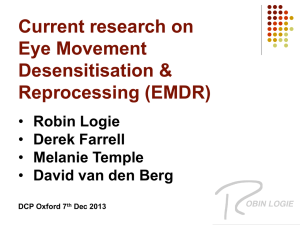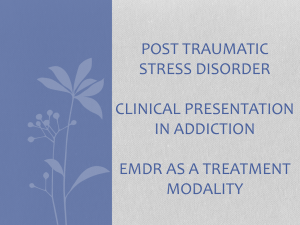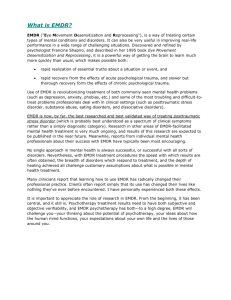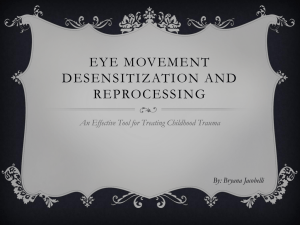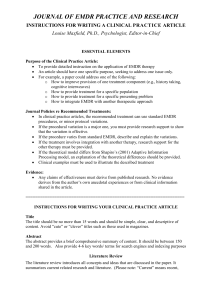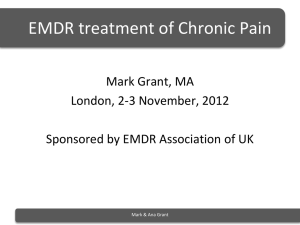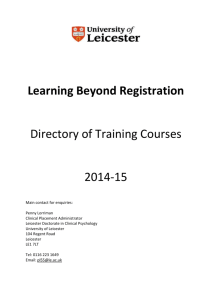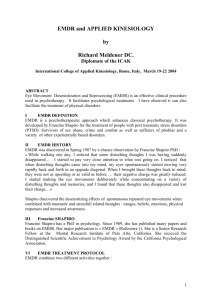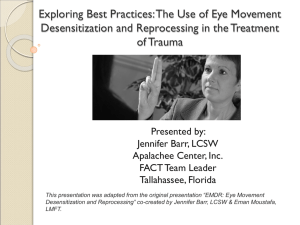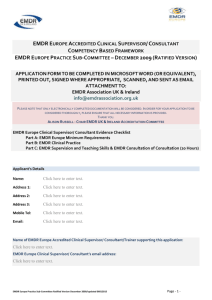17 `Eye Movement Desensitisation & Reprocessing (EMDR)`
advertisement
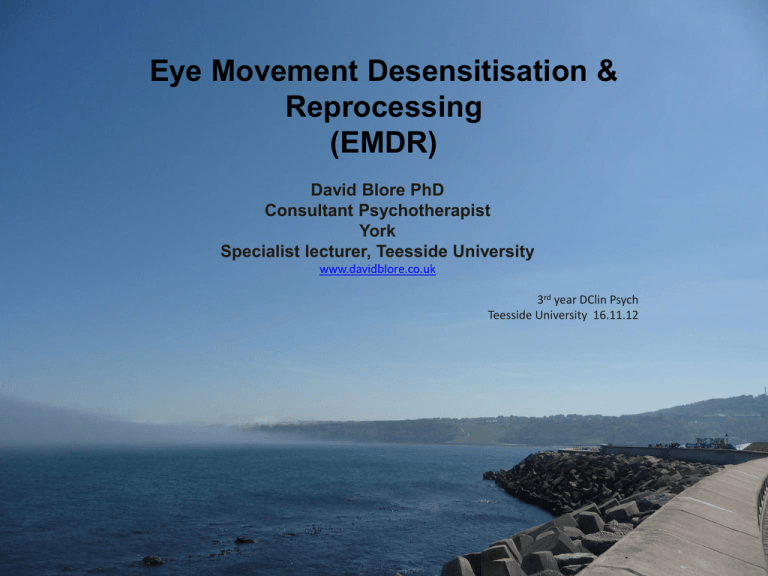
Eye Movement Desensitisation & Reprocessing (EMDR) David Blore PhD Consultant Psychotherapist York Specialist lecturer, Teesside University www.davidblore.co.uk 3rd year DClin Psych Teesside University 16.11.12 Introductory discussion • Who has heard of EMDR? • What have you heard? • NICE recommendations for PTSD • March 2005 • Reviewed December 2011 • PTSD, ASD, Adjustment Disorder (DSM IV TR) • Volunteers needed after the break! Objectives and Agenda What is, and isn’t, EMDR The eight phase model Reconsolidation of Memory; Adaptive Information Processing Video parts 1 & 2 Break Video part 3 Demonstrations Potential of EMDR Further reading/ resources What EMDR isn’t 1. CBT 2. Exposure therapy 3. NLP 4. Hypnosis 5. A commercial gimmick What EMDR isn’t 6. The eye movements are irrelevant Dismantling studies originally focussed on the role of eye movements (e.g. Tallis & Smith 1994). The conclusions were that the eye movements were redundant and thus EMDR amounted to a form of imaginal exposure. However, Propper & Christman (2008) and Gunter & Bodnar (2009) have shown EMs have a direct effect on memory retrieval, attention flexibility, quality and vividness of the memory itself. Jeffries & Davis (2012) have argued that eye movements are an essential component of EMDR What is EMDR? • It is an eight phase treatment: Commencing with history taking, preparation and specific target assessment and then moving to desensitisation, installation and body scan, finishing with closure and starting the following session with a re-evaluation It follows that EMDR is not just “finger wagging”… What is EMDR? • It is an information processing based therapy: EMDR did not grow out of a theory prediction but from an accidental and replicable observation: “…disturbing thoughts lost much of their power when I engaged in a particular kind of repeated saccadic (i.e. rapid and rhythmic) eye movements. Indeed, these thoughts disappeared altogether and if deliberately retrieved, no longer seemed valid.” (Shapiro 1991 p.133, contents of brackets added; see also Shapiro 1989b) General agreement that EMDR functions according to the Adaptive Information Processing (AIP) theory*, which was devised specifically to account for the changes observed in EMDR (Shapiro 2001; Dworkin 2005, pp223-4) What is EMDR? Although AIP is the acknowledged theoretical framework to explain how EMDR works, it is by no means the only theory to account for observed changes. Nine other theoretical mechanisms have been identified (Shapiro 2001, pp. 324-38) of which Reconsolidation of Memory Theory (Cahill & McGaugh 1998) is the arguably the best neurophysiological theory of psychological change What is EMDR? Open access searchable database of everything EMDR: http://emdr.nku.edu Nearly 7000 references Excellent efficacy summary: http://www.emdr.com/efficacy.htm Includes all current RCTs and meta analyses plus commentary Demonstration of EMDR Volunteers needed! Check on safety Demonstrations: 1. Old anxiety 2. Phobia – to include float back Demonstration of EMDR T NC PC VoC E SUDS L > > > > > > > What is the potential of EMDR? • PTSD and similarly obviously traumatic conditions • Relapse prevention in OCD • Ultra low BMI eating disorders • Etc. Requires a modified definition and conceptualisation of “trauma”: Unresolved distressing life events on a ‘distress continuum’ give rise to mental health dis-ease What is the potential of EMDR? • • • • • Phobias and the 70-30 ‘rule’ GAD MUPS and pain generally particularly phantom limb Clients with ‘locked-in syndrome’ Etc. But this only addresses negative mental health… Maslow’s criticism of the ‘negative only’ view of mental health: • “The science of psychology has been far more successful on the negative than on the positive side. It has revealed to us much about man’s shortcomings, his illness, his sins, but little about his potentialities, his virtues, his achievable aspirations, or his full psychological height. It is as if psychology has voluntarily restricted itself to only half its rightful jurisdiction, and that, the darker, meaner half.” (Maslow 1954) What is the potential of EMDR? • Performance enhancement – the British Olympic team has an EMDR Consultant • Personal Development – business coaching • EMDR and mindfulness go well together • Positive Psychology & EMDR – www.linkedin.com group • Etc.
